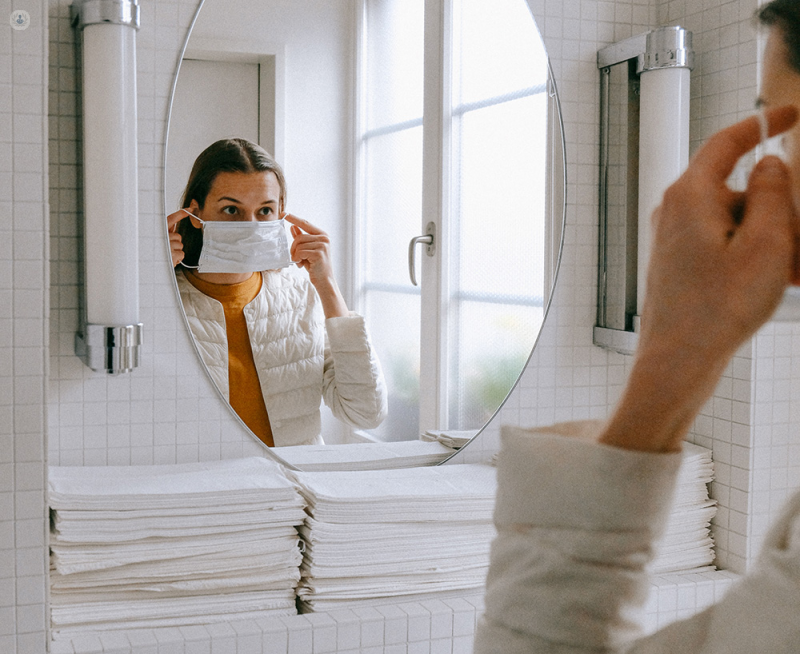How to overcome mask anxiety
Escrito por:As the COVID-19 coronavirus continues to spread around the globe, some people having to wear a face mask have felt their anxiety levels rise to new heights. In this article, Dr Sue Peacock, a consultant health psychologist based in Bedford, Milton Keynes and online explains why some people feel uncomfortable wearing a face mask and what they can do to overcome it.

Why do some people feel uncomfortable wearing face masks?
While we are aware of the health benefits of wearing a face mask, it doesn’t necessarily make everyone feel more comfortable about wearing them, as the reasons behind their anxiety can vary greatly.
Some people don’t like wearing masks for several reasons which can include:
- Feelings of claustrophobia
- Worried about not being able to breathe
- Feeling more anxious because it’s a visual reminder of the pandemic
- Feeling a gagging sensation when wearing a mask, or feeling they are being smothered
- Fears of having low oxygen levels
Throughout our lifetime, phobias can develop at any point, and there are a wide variety of factors that can trigger them. For some people, wearing a face mask can bring about feelings of suffocation or claustrophobia. They can either present as mild symptoms of anxiety or even extreme symptoms such as panic attacks.
What causes ‘mask anxiety’?
Some people have a highly sensitive ‘false suffocation alarm’, which causes them to believe they are suffocating when they aren’t. It can be triggered by small changes in our breathing patterns as a reaction to our anxiety. This feeling is not unique to face coverings — this is true of wearing sleep apnea masks or Halloween masks too!
So, when someone with anxiety senses a subtle change in their breathing pattern when wearing a mask, they may perceive this change as being short of breath which was caused by the mask. It then makes them feel more anxious and starts a trail of catastrophic thoughts such as ‘I’m suffocating’ or ‘I’m dying’. They then start breathing harder and faster and sets off the panic cycle.
During a panic cycle, adrenaline starts pumping and anxiety goes through the roof. It results in the person quickly whipping off their mask to find that much-needed relief. They then naturally conclude that the mask was suffocating or even killing them.
How can people feel more comfortable wearing face masks?
We must help and support people to wear masks, rather than judging them for not wearing them. It’s not only beneficial for their health but public health too to help prevent the spread of the coronavirus. To do this, we need to validate people’s experiences and educate them that they are not in danger of wearing a mask.
Remember that the fear of suffocation, anxiety and panic are common. They happen because you have a brain that is highly susceptible to sensations of suffocation and you are prone to having an anxious reaction to these sensations. But you are not in danger of wearing a mask.
How can a psychologist help?
A psychologist can help you remove this false impression that you are suffocating and help you to feel more comfortable wearing a mask. The approach they use is evidence-based and called exposure therapy.
During exposure therapy, you will learn how to get rid of your fear reaction that arises when you feel like your breathing is obstructed.
Usually, when we are faced with something we fear, we often take too many breaths and too quickly, which causes hyperventilation. Breathing like this consequently decreases the amount of oxygen-rich blood that flows to our brain. So, we need to start by practising a type of breathing exercise that counteracts the air gasping that happens when you perceive you are suffocating.
‘Equal breathing’ exercise to try at home
Equal breathing is a type of breathing technique you can try the next time you feel anxious about wearing a face mask. The technique stems from the ancient practice of pranayama and involves inhaling for the same amount of time as you are exhaling.
- Shut your eyes and pay attention to the way you breathe normally for several breaths.
- Slowly count 1-2-3-4 as you inhale through your nose.
- Exhale for the same four-second count.
- As you inhale and exhale, be mindful of the feelings of fullness and emptiness in your lungs.
- As you continue practising equal breathing, your second count might vary. Be sure to keep your inhale and exhale the same.
Practise putting on and wearing your mask
When you begin feeling confident with this breathing technique, the first step is to hold the mask in front of your face, but do not put it on your face. Breath slowly and deeply until you no longer feel anxious for at least five minutes. Then set the mask aside.
Every time you repeat this process, gradually bring the mask a little bit closer to your face and repeat it until you feel comfortable wearing the mask on your face with the loops around your ears. Remember, when the mask is on, keep breathing slowly and deeply until your anxiety has resolved and you feel you can breathe normally. Whenever you feel your anxiety ramping up, practise your equal breathing again.
If you feel your anxiety or sense of suffocation increasing anytime during this process, you should repeat to yourself that you are not suffocating and not in danger. Always remember to breathe slowly and deeply and wait until your anxiety has gone.
You may find that practising wearing your face mask around the house helps — especially if you are afraid of panicking in public. You must remember not to take the mask off when you feel your anxiety increasing, as this only reinforces your fear. Try to maintain your breathing through the anxiety and only take the mask off when your anxiety has settled.
If you have tried this technique but would like some more help, there is a complimentary audio download in the resources section of my website.
If you still feel anxious about wearing a face mask and would like to talk to a psychologist, book a consultation with Dr Sue Peacock via her Top Doctors profile.


